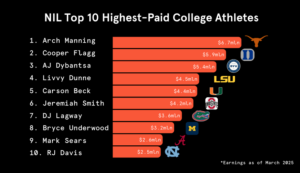I have been a massive Kansas Jayhawks men’s basketball fan. My mom went to the University of Kansas for college, and as far back as I can remember, she instilled the red and blue Jayhawks in me. Watching the game is a tradition in my household.
I remember the 2022 NCAA Division 1 March Madness like it was yesterday. I remember getting up and screaming at the television during each round Kansas played. The nerves, the joy. Nothing beats coming back down 15 points to the University of North Carolina to win the championship (we also have family in Chapel Hill, North Carolina, which made it better).
But college basketball is taking a path that is significantly harming the game: granting players the right to earn money based on their name, image, and likeness (NIL). Now, it’s not that I don’t think college players should make money on their NIL, but I think there needs to be more rules about giving universities an equal opportunity to pay players.
Players finally started to be able to make money after the NCAA adopted a policy allowing college athletes to make money based on their NIL, which was passed on July 1, 2021. It came too late to affect my 2022 Kansas Jayhawks from winning the championship.
Who knows how March Madness would’ve played out if the law had been passed a year sooner? NIL benefits players from transferring schools because they can drive the price it takes to get a player up.

In 2020, Meechie Johnson started as a freshman for the Ohio State Buckeyes, where he played for two years. During his time at Ohio State, the policy allowing players to earn money based on their NIL got passed. In 2022, Johnson transferred to the South Carolina Gamecocks and played two seasons there. After the 2024 season, he transferred back to Ohio State and played there for a season. Now, in 2025, he has transferred back again to South Carolina. This has been a running meme and makes the transfer portal a joke.
Before July 1st, 2021, student athletes were prohibited from making money. This caused much controversy, especially because college basketball brings in so much money. According to the AP, during the 2022-2023 season the NCAA generated $1.3 billion. March Madness is one of the most-viewed sporting events year-round. But none of the student athletes ever saw it.
I 100% believe college athletes should get paid, but this implementation of NIL without many regulations has blown it out of proportion, significantly harming the game.
In the NBA, players sign contracts that range from one to five years, and free agency begins once their contract expires. In college, it feels as if every college player is signed to a one-year deal. Then, they enter “college free agency,” also known as the transfer portal, and join a different school’s program the following year.
The year before players could make money on their NIL, according to on3, one of the main sources for transfer portal tracking, 466 players entered the transfer portal in 2021. In 2025, the number shot up 137.55% to 1,107 men’s basketball players entering the transfer portal.
My Kansas University men’s basketball team lost nine players after this season. Five graduated, and four entered the transfer portal. Bill Self, the head coach, will build a roster from scratch next year through the transfer portal.
The transfer portal incentivizes players to seek other athletic programs and see the “highest bidder” so they can make the most money one year and then do the same process the following year.
Some say that the players have worked hard, have talent, and earned this money. But this is ruining college basketball’s overall viewership and taking it down a dark path that, if it continues, will destroy one of the most-viewed sports.
“The NIL, in my opinion, has canceled the Cinderella stories for team sports. We saw it this year in the NCAA tournament,” said Gamal Abiona, the deputy director of athletics at Hunter College. Cinderellas are the unexpected teams that have success in March Madness. College basketball and March Madness originally created an environment where anyone could beat anyone in any game. NIL is now creating an environment where that’s becoming less possible.
This year, all four one-seeds in March Madness advance to the final four. Before this year, it had only happened two other times since the tournament increased to 68 teams in 1985. The budgets of these schools are drastically larger than those of the mid- and low-major schools, and that’s where a change is needed.

According to SBNation, a program like Brigham Young University (BYU) has an NIL budget for its men’s basketball team estimated at around $12 million. A school like Belmont University, a much smaller school that competes in a smaller conference, is an estimated $291,667, according to Belmont Vision.
Schools need to have a cap on how much they can offer players. A school like Belmont would never be able to compete with a school like BYU in the transfer portal or in recruiting freshmen. They need to have a cap on what players can make or a cap on the amount a school can offer so we can give athletes the incentive to go to these lower or mid-major schools.
Universities and colleges could also get athletes to sign multiple-year contracts. This would strengthen basketball programs and give smaller schools a better chance to keep their players rather than have them transfer to the bigger programs.









